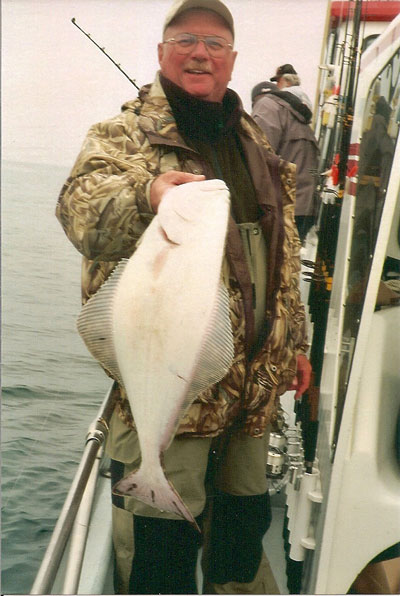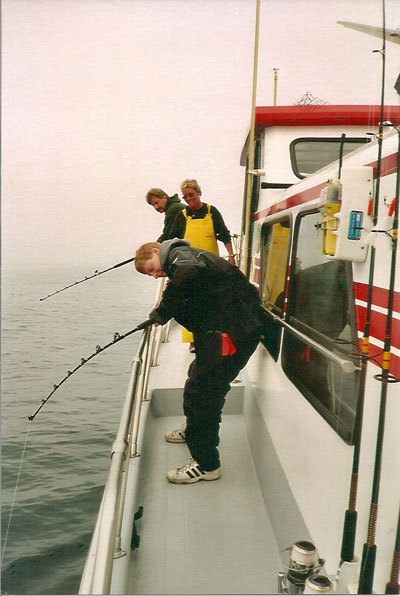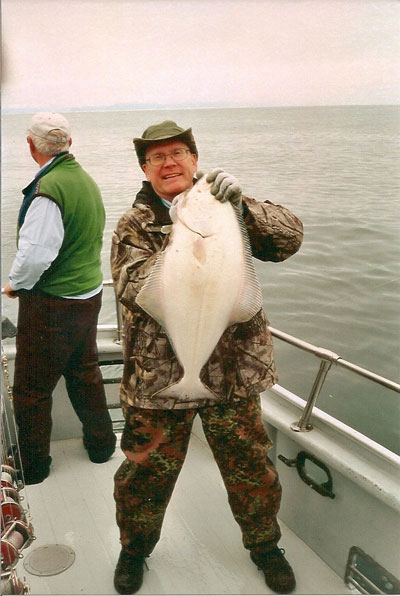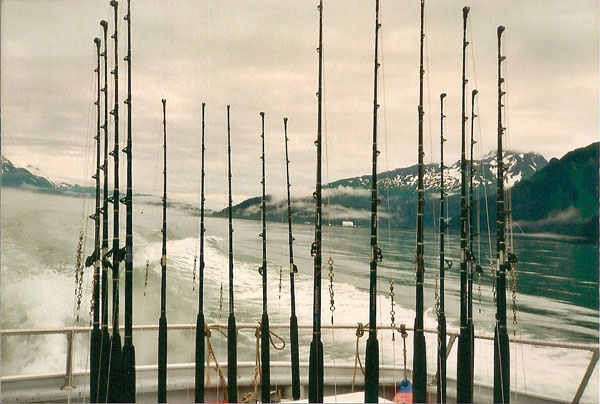Halibut Fishing In Alaska
A cool, damp breeze blows in across Resurrection Bay as we walk along the dock in the harbor at Seward, Alaska. The breeze gently rocked the boats that are tied up in their slips. It is a gray day. Low clouds cut off the tops of the mountains around us. It had rained off and on again the day before, when we had driven from Anchorage to Seward. It looks like that kind of weather will continue today.
Heavy rods and reels are standing upright in rod holders as we crawl on board our boat, the Artic Warrior. The Captain’s name is Carrie and she tells us that we will have good fishing today. The deck hands loosen ropes as the motor on the boat rumbles into life and we pull away from the dock.
As Seward drops behind us it is engulfed in fog and we loose it in the swirling mist. Our two deck hands are busy doing things around the boat. One of them is a young man, Nick and the other is a young lady, Anita.
The port of Seward has been lost in the fog in the distance behind the boat for some time. But the rest of Resurrection Bay is stunning even with gray skies overhead. The bright greens on the mountains seem to jump out at you. The taller vegetation is darker green and the shorter vegetation is lighter, almost a lime green color to it. Ribbons of snow run down the mountains contrasting sharply to the greens around it. The further we go down the bay the more mountains we see. Some of the clouds have lifted although it is still overcast. The mountain tops are dark gray from the rocks topped off with the bright, forbidding white of ice and snow.
The eight fishermen that comprise our group come from various parts of the country. There is Dennis Virden and his son, Phillip both from Minnesota. Dennis’ brother Gene and his son Eric live in Alaska. Gene’s other son, Kevin and his friend, Andrea Villa, are from San Diego, California. Charlie Bunch, a friend of Gene’s, also lives in Alaska. I live in Wisconsin. Besides our group there are five other fishermen on board for a total of thirteen of us.
As Resurrection Bay falls behind us we pass a long gravel bar that sticks out into the water. A few wind swept trees hold tight to this strip of rock and gravel. Rounding the bar, we now head into the ocean. The ocean is gray and we rock back in forth in the rolling waves. Dennis, Phillip and I sit on the open back deck.

I am wearing a long sleeve shirt, a fleece jacket, a down vest and over that I have my rain gear. I must admit that I am comfortable. Anything less then that I would have been cold. I am quite comfortable on the back deck. I spot a glacier. The glacier is a river of blue ice spilling into the ocean.
It takes us three hours to get to our fishing area. We see an island coming up out of the ocean. There are two other boats floating in front of us and I can feel our boat beginning to slow down. The cabin empties out and now everyone is standing on the back deck. The young lady deck hand and the captain brief us as to how we are going to fish. They tell us that we will be fishing in over a hundred feet of water and that there is a strong current so we will need four pounds of weight to get to the bottom. Four pounds of weight! I find that hard to believe but when I look at the rods there are two bars of lead attached to each line. For someone from the Mid West, like Dennis and I, seeing those two chunks of weight dangling from our lines it seems like dropping an anchor into the water to get our baits to the bottom.
While Anita is telling us how to let our bait drop with the four pounds of weight while not fouling up the line on the reels, the Captain is demonstrating the technique. She then instructs us that when a fish hits we will know it and should just start reeling up the line. No need to set the hook like us freshwater fishermen are used to. She tells us that when a fish hits we need to yell “fish on” to alert the deck hands that someone has a fish and then when we get the fish to the side of the boat that we need to yell “color.” That notifies the deck hands to respond immediately with a gaff. Anita had no more then finished her instruction when the Captain yelled “fish on.” The pool cue like rod she is holding is bent over as a fish on the other end is fighting against the rod and four pounds of weight some hundred feet below. She hands the rod to the fisherman nearest her and tells him to bring in the fish.
With that there is a scramble for rods with everyone trying to find a place along the rail to drop their baits. Even with four pounds of weight our lines drifted behind us with the strong current. Our boat catches a couple of fish when the Captain announces that we need to move the boat to adjust to the current.
The boat is repositioned and once again we drop our baits overboard. Andrea is the first one in our group to catch a halibut. I hear her yell ut “fish on.” Then Gene is next. He is just a couple of fishermen down from me and I see him furiously cranking on his reel with the heavy salt water rod bent over.
Then it is me. I had wondered if I truly was going to be able to feel a fish strike with four pounds of weight in strong current some hundred feet or so below me. But as Anita said you will know when you a fish hits. I felt the line tighten up and I reeled up the slack and I could feel the unmistakable thumping of a fish against the rod. I guess that it feels the same regardless if you are fishing for halibut in over a hundred feet of water on the ocean or for walleyes in ten feet of water back in northern Minnesota.
The fish pulled away straining against the thick fiberglass rod and heavy salt water reel. I feel the fish surge off and I turn the fish while continuing to crank the reel. Between the four pounds of lead and the fish I feel the strain against my arms and shoulders. The fish does not run off in a burst of speed but has a continuous pull against the rod that is tiring. By the time I see the brown flat shape of a halibut come through the water and yell “color” the muscles in my arms and shoulder are crying for relief. Nick, the other deck hand, came running alongside of me, reached over with a long handled gaff and leaning over, hooked the fish and dragged it into the boat. My halibut is about twenty pounds.
Halibut are some of the best tasting fish in the world but they are one strange looking fish. They are a flat fish. The side that runs along the bottom is pure white while the other side that is up is brown. The white side that hugs the bottom does not have an eye.
Halibut put up a strong, determined battle. Although I feel a bit worn out by the fight, I quickly bait my hook and drop it back overboard. There are more fish in the sea and it is in the nature of fishermen to want to get another fish. I did have to wonder if that fish had been that tough to get along side the boat what it must be like to catch a halibut that went lets say a hundred or more pounds and they are out there. Most halibut that we caught ran from twenty to thirty pounds. The world record halibut is 459 pounds caught in 1996.
A few minutes after I catch my fish Dennis gets his first fish. Our limit is two fish per person. Shortly after that I get a second fish to fill my limit. The second fish is a bit bigger then the first. I take a seat and get out a bottle of water. Phillip drops his bait down and it must have no sooner hit the bottom when a fish hits and he yells fish on”.
We all fill our limits and the Captain puts it up to a vote. We can continue to fish where we are for ling cod. We can only catch one of them. Or we can try for salmon. There is no guarantee on salmon but

there are some silver salmon about we are told. Fishermen are fishermen and we all realize that there is no guarantees. That is why they call it fishing instead of catching. The boat votes for salmon.
Another island looms up in front of us but this time we can see land in the background. Seagulls scream, float and dive overhead. The water here is a light turquoise color and the island is a bright green. A light, damp fog has settled in around us. We will be using spinning reels now with pink and white jigs. We are told to just drop them overboard, let them sink a few seconds and then slowly bounce it. It sounds similar to walleye fishing to me.
A few minutes after we start Andrea, on one side of me, catches the first salmon just like she did with the halibut. A few minutes later, Dennis on the side catches a salmon. Dennis’ spinning rod is bent double as the fish races off and I can hear the drag whining as it gives out line. In a moment or two he has the fish alongside the boat. It is silver flash in the clear water as the fish darts off. The fish is twisting and turning as the net is extended and then it is brought into the boat. A few minutes Phillip catches a salmon.
Our boat catches a number of salmon by the time that we quit and begin to motor back to Seward. Halibut was our main attraction but it also was nice to pick up a few bonus salmon for what was a great day of fishing in Alaska.
Although halibut fishing can be found from Oregon and Washington state all the way north to Alaska it is the cold ocean water off Alaska where the best halibut fishing in the world is found. For visiting fishermen it is easy to arrange a day of fishing for halibut. Most of the ports along the Alaskan coast have boats that provide fishing for halibut. Most of the charters are one day fishing trips but there are some over night charters available that provide two days of fishing. A day charter is very reasonable and normally costs from $250 to $300.

Charter boats provide all the bait and fishing equipment that you will need. You need to bring your own food and drink. Dress warm. On our day of fishing it was mid July but it was still fairly cool on the ocean. Reservations are normally required. To find charter boats just Google search for Alaskan halibut or halibut fishing from the port you will be visiting. Many of the charter boats services either have lodging and dinning packages available or can recommend places to stay and eat.
Halibut are great to eat. Most of the charters can provide cleaning services for the fish you catch. However, I filleted my fish and found halibut to be even easier to fillet then the walleyes I catch in my home state of Wisconsin. Again the charter services can help with freezing, packaging and shipping the fish back to your home.
A week later on a hot, humid summer day back home in Wisconsin, Alaska comes back to me with a ring of the doorbell and a delivery man standing on my front steps with box of frozen halibut and salmon fillets. “How was the fishing,” he asked.

 I am wearing a long sleeve shirt, a fleece jacket, a down vest and over that I have my rain gear. I must admit that I am comfortable. Anything less then that I would have been cold. I am quite comfortable on the back deck. I spot a glacier. The glacier is a river of blue ice spilling into the ocean.
I am wearing a long sleeve shirt, a fleece jacket, a down vest and over that I have my rain gear. I must admit that I am comfortable. Anything less then that I would have been cold. I am quite comfortable on the back deck. I spot a glacier. The glacier is a river of blue ice spilling into the ocean. there are some silver salmon about we are told. Fishermen are fishermen and we all realize that there is no guarantees. That is why they call it fishing instead of catching. The boat votes for salmon.
there are some silver salmon about we are told. Fishermen are fishermen and we all realize that there is no guarantees. That is why they call it fishing instead of catching. The boat votes for salmon.








